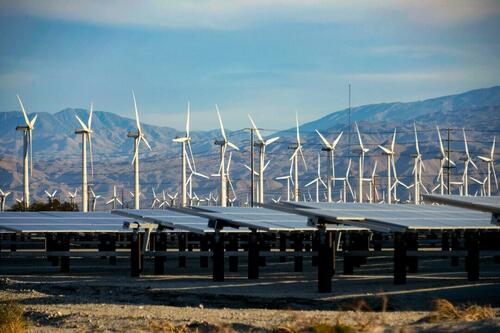Californian Households To Receive Climate Credit In October Utility Bills To Offset Increased Prices
Authored by Travis Gillmore via The Epoch Times,
More than 11.5 million customers of privately owned utility companies in California will automatically receive an average credit of $71 on their October utility bills, Gov. Gavin Newsom said in an Oct. 2 statement.
The climate credits are intended to help “offset increases while preserving the incentive for customers to conserve energy and reduce [greenhouse gas] emissions,” according to the California Public Utilities Commission’s website.
Funding comes from the state’s cap-and-trade program, which regulates the amount of carbon produced by companies and requires those that exceed limits to pay fees.
Credit amounts vary for utility providers. The more than 5 million households that rely on the largest energy company in the state, PG&E, will receive $55.17.
About 46,000 Californians served by Pacific Power—an energy company operating in the far northern part of the state—will see the largest credits of $174.25.
Bear Valley Electric Service—offering power to 23,000 residents in the Alpine County region known for its ski area—customers will receive the smallest credit at $32.24.
“Not only does this credit provide much-needed relief for families, it’s helping Californians make the switch to cleaner energy,” Gov. Gavin Newsom said in the statement.
A similar credit was applied to customers’ bills in April, with the total for the year averaging $217.
Households have received an average of $971 in climate credits since 2014, amounting to more than $14 billion across the state, according to the governor’s office.
Some critics have said the state’s climate policies amount to high-priced fees that negatively affect consumers.
“To reduce greenhouse gases marginally in this state, we have this very expensive program called cap-and-trade, which is a hidden tax on energy,” Susan Shelley, a journalist based in Southern California, told EpochTV’s “Leaving California” documentary last year.
“It’s on utilities, it’s on refineries, it’s on manufacturing, it’s on everything.”
A study titled “Zapped: How California’s Punishing Energy Agenda Hurts the Working Class” published in 2022 found that higher utility prices were affecting millions of Californians.
“There is nothing unique about California that should cause the state’s electricity rates to be significantly higher than the rest of the country,” Wayne Winegarden wrote in a report analyzing the study.
“Instead, the results are the expected and desired outcome from … Sacramento’s energy policy agenda of recent years.”
The regulator in charge of overseeing the industry said the state’s green energy policies are, in part, responsible for rising electricity prices.
“This all comes at a cost,” Alice Reynolds, president of the California Public Utilities Commission, said during a March hearing of the Assembly’s Utilities and Energy Committee when questioned by lawmakers about energy prices.
“Any investment in clean energy technology … is funded through electricity bills.”
Lawmakers began discussing the cap-and-trade program in 2006, with an agreement reached in 2012, and the law took effect the following year.
Since then, energy prices have increased significantly in the state with more than a dozen increases since 2019. Californians paid about 67 percent more than the national average for electricity in 2022, and some Golden State residents pay more than five times the rate per kilowatt hour charged in the lowest-priced areas in the country, according to statistics from the U.S. Energy Information Agency.
Utility companies, including PG&E, included comments in rate request filings noting that some added costs are attributed to the state’s decarbonization strategy.
“We are also experiencing the impact of the State’s decarbonization strategy, particularly on our gas distribution system,” PG&E said in the 2021 filing.
“Numerous cities have adopted ordinances prohibiting gas appliances in new construction. The projected decline in throughput may lead to a declining base of core customers who will pay for our gas system costs, with rate increases needed to cover that gap.”
Legislators on both sides of the aisle pointed to the state’s climate agenda as contributing to the high cost of living in California.
“These energy mandates jacked up utility rates,” Republican Assembly Minority Leader James Gallagher told The Epoch Times on Feb. 26.
“All of this stuff has a cost.”
He said the state is forcing taxpayers and electricity and fuel consumers to pay for inefficient climate policies.
“All of this stuff we’ve been doing on climate is super-expensive, and it’s just going to get more expensive,” Gallagher said in March.
Lawmakers from the Democratic Party have also spoken about calls they were receiving from constituents concerned about energy prices jeopardizing their finances and the unintended consequences of some legislative policies.
“Rates are skyrocketing in California. The harsh reality is that millions of Californian families are at the breaking point right now,” Assemblywoman Cottie Petrie-Norris, chair of the energy committee, said during the March hearing while highlighting statistics that showed California has the highest utility rates in the nation. “Our constituents want to know what’s going on and more importantly, they want to know what we, as their elected officials, are doing to address this issue and contain costs.”
Businesses are also paying the price, she said.
“High energy prices are also a major challenge for California businesses, particularly our small businesses, who are struggling to keep their doors open, and, quite literally, keep their lights on,” Petrie-Norris said.
More than a million small businesses will also receive credits on their October bills, according to the governor’s Oct. 2 statement.
Tyler Durden
Wed, 10/09/2024 – 05:45
via ZeroHedge News https://ift.tt/O35UZJ4 Tyler Durden
